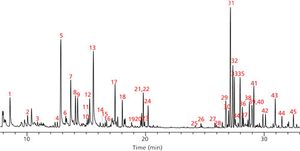
As the legalization of medicinal cannabis continues to sweep across the United States, an urgent need has developed for fast, accurate and efficient analytical testing. In addition to testing for contaminants and potency, there is also interest in the determination of terpene identity and concentration levels present in different strains of cannabis. Terpenes have been shown to have therapeutic uses for treatment of different medical conditions ranging from cancer and inflammation, to anxiety and sleeplessness. It is believed that the combination of terpenes and cannabinoids in cannabis produce a synergistic effect with regards to medical benefits. The traditional testing method for terpenes in plant materials involves a solvent-based extraction followed by GC analysis. In this work, headspace solid phase microextraction (HS-SPME) was used to identify and quantify terpene content in cannabis. The HS-SPME method provided several advantages over solvent extraction in that it provided a cleaner analysis, free of interferences from co-extracted matrix, and was non-destructive to the sample. A cannabis sample of unknown origin was first analyzed qualitatively by HS-SPME and GC-MS. Spectral library matching and retention indices were used to identify 42 different terpenes. Quantitative analysis was then performed for several selected terpenes using spiked samples. Method accuracy was >90%, with reproducibility of





